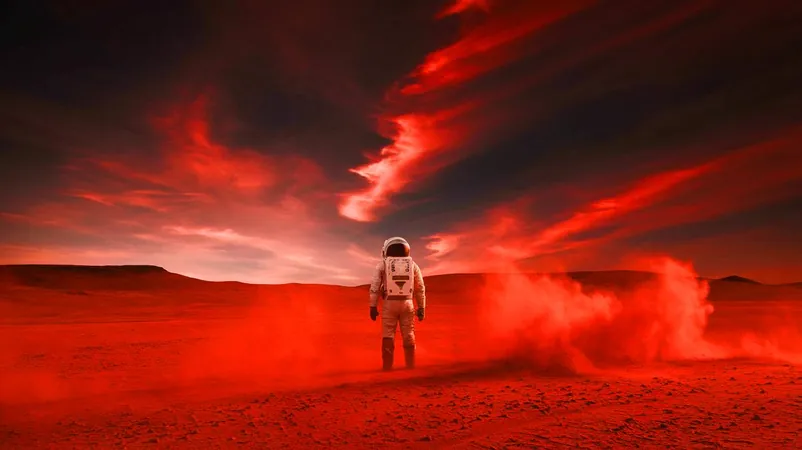
Alien-like Threat Lurks: Massive Mars Dust Storms Jeopardize Hopes for Human Survival
2025-03-29
Author: Mei
The Invisible Respiratory Hazard
Martian dust, made up of harmful components like silica, gypsum, perchlorates, and iron oxides, presents severe respiratory risks. The particles are significantly smaller than those found on Earth, roughly 25 times thinner than a human hair, which allows them to infiltrate deep within lung tissues and potentially into the bloodstream. According to Justin Wang, a medical student involved in recent research, "The biggest danger is the risk to astronauts' lungs. The dust's fine nature means it can linger in lung tissue and gradually enter the bloodstream."
The consequences may resemble long-term health issues similar to those caused by asbestos exposure, leading to respiratory diseases that could jeopardize missions in space. Unlike Earth’s dust, which typically becomes smoother over time, Martian dust remains sharper and more abrasive, causing additional irritation. Moreover, perchlorates found in Martian soil may contribute to thyroid problems and potential blood disorders, presenting further health complications for astronauts on prolonged missions.
Impact on Mission Success and Equipment
The potential impacts of Martian dust are not limited to human health; they extend to the mission-critical equipment as well. Continuous dust accumulation poses a threat to solar panels and scientific machinery, potentially crippling power sources and causing malfunctions. The historical challenges observed during lunar missions, such as dust infiltrating suits and habitats, serve as a stark reminder of what could be at stake.
On Mars, these challenges are poised to be even more severe due to the toxic nature and durability of the dust. Ensuring robust equipment that can withstand this environment is imperative, highlighting the necessity of innovative engineering solutions to address this pervasive issue.
Surviving in a Harsh Environment
The vast distance from Earth complicates rapid evacuation in emergencies, and the communication delays hinder real-time support for astronauts. Therefore, robust medical infrastructure will be essential on Mars. As Jonathan Eastwood, a space physicist at Imperial College London, articulates, “Rapid evacuation isn’t an option; astronauts must have comprehensive medical support on-site.”
To counter the threats posed by Martian dust, engineers are actively researching various technologies such as advanced air filtration systems, self-cleaning suits, and innovative electrostatic repellents. However, as Julia Cartwright from the University of Leicester notes, the challenge of maintaining air quality and securing a sufficient supply of replacement filters adds significant logistical burdens that necessitate meticulous planning.
Optimism Amidst Difficulties
In spite of the formidable challenges presented by Martian dust, the research community remains hopeful. Wang emphasizes, “Mars dust won’t be the most dangerous aspect of the mission, but it’s a real hazard. With the right preparation, it’s something we can manage effectively.” This spirit of determination reflects a growing recognition among scientists that while daunting, overcoming the obstacles associated with Martian dust is manageable with proper foresight.
Preparing for Tomorrow: The Future of Mars Exploration
Insights from recent studies published in GeoHealth highlight the critical need to confront the challenges posed by Martian dust in mission planning. As a scientific community, the focus on developing feasible solutions becomes crucial for successful future Mars missions. The capability to manage environmental hazards not only ensures astronaut safety but also lays the groundwork for sustainable human exploration of Mars.
From enhancing air filtration technologies to designing resilient equipment capable of enduring dust attacks, this preparation is as vital as any aspect of the mission itself. Continued research and technical advancements will be pivotal in protecting astronauts while paving the way for a more assured human presence on Mars.
As we venture into the unknown realms of Martian exploration, one undeniable question persists: How will humanity adapt to confront and overcome the challenges of living on another planet? The answers may very well determine our prospects in this audacious journey into the cosmos.

 Brasil (PT)
Brasil (PT)
 Canada (EN)
Canada (EN)
 Chile (ES)
Chile (ES)
 Česko (CS)
Česko (CS)
 대한민국 (KO)
대한민국 (KO)
 España (ES)
España (ES)
 France (FR)
France (FR)
 Hong Kong (EN)
Hong Kong (EN)
 Italia (IT)
Italia (IT)
 日本 (JA)
日本 (JA)
 Magyarország (HU)
Magyarország (HU)
 Norge (NO)
Norge (NO)
 Polska (PL)
Polska (PL)
 Schweiz (DE)
Schweiz (DE)
 Singapore (EN)
Singapore (EN)
 Sverige (SV)
Sverige (SV)
 Suomi (FI)
Suomi (FI)
 Türkiye (TR)
Türkiye (TR)
 الإمارات العربية المتحدة (AR)
الإمارات العربية المتحدة (AR)